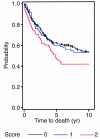Transcriptional activation of integrin beta6 during the epithelial-mesenchymal transition defines a novel prognostic indicator of aggressive colon carcinoma
- PMID: 15668738
- PMCID: PMC544606
- DOI: 10.1172/JCI23183
Transcriptional activation of integrin beta6 during the epithelial-mesenchymal transition defines a novel prognostic indicator of aggressive colon carcinoma
Abstract
We used a spheroid model of colon carcinoma to analyze integrin dynamics as a function of the epithelial-mesenchymal transition (EMT), a process that provides a paradigm for understanding how carcinoma cells acquire a more aggressive phenotype. This EMT involves transcriptional activation of the beta6 integrin subunit and a consequent induction of alphavbeta6 expression. This integrin enhances the tumorigenic properties of colon carcinoma, including activation of autocrine TGF-beta and migration on interstitial fibronectin. Importantly, this study validates the clinical relevance of the EMT. Kaplan-Meier analysis of beta6 expression in 488 colorectal carcinomas revealed a striking reduction in median survival time of patients with high beta6 expression. Elevated receptor expression did not simply reflect increasing tumor stage, since log-rank analysis showed a more significant impact on the survival of patients with early-stage, as opposed to late-stage, disease. Cox regression analysis confirmed that this integrin is an independent variable for these tumors. These findings define the alphavbeta6 integrin as an important risk factor for early-stage disease and a novel therapeutic candidate for colorectal cancer.
Figures








References
-
- Hay ED. An overview of the epithelio-mesenchymal transformation. Acta Anat. 1995;154:8–20. - PubMed
-
- Savagner P. Leaving the neighborhood: molecular mechanisms involved during epithelial-mesenchymal transition. Bioessays. 2001;23:912–923. - PubMed
-
- Theiry JP. Epithelial-mesenchymal transitions in development and pathologies. Curr. Opin. Cell Biol. 2003;15:740–746. - PubMed
-
- Oft M, et al. TGF-beta1 and Ha-Ras collaborate in modulating the phenotypic plasticity and invasiveness of epithelial tumor cells. Genes Dev. 1996;10:2462–2477. - PubMed
-
- Oft M, Heider KH, Berg H. TGFβ signaling is necessary for carcinoma cell invasiveness and metastasis. Curr. Biol. 1998;8:1243–1252. - PubMed
Publication types
MeSH terms
Substances
Grants and funding
LinkOut - more resources
Full Text Sources
Other Literature Sources

